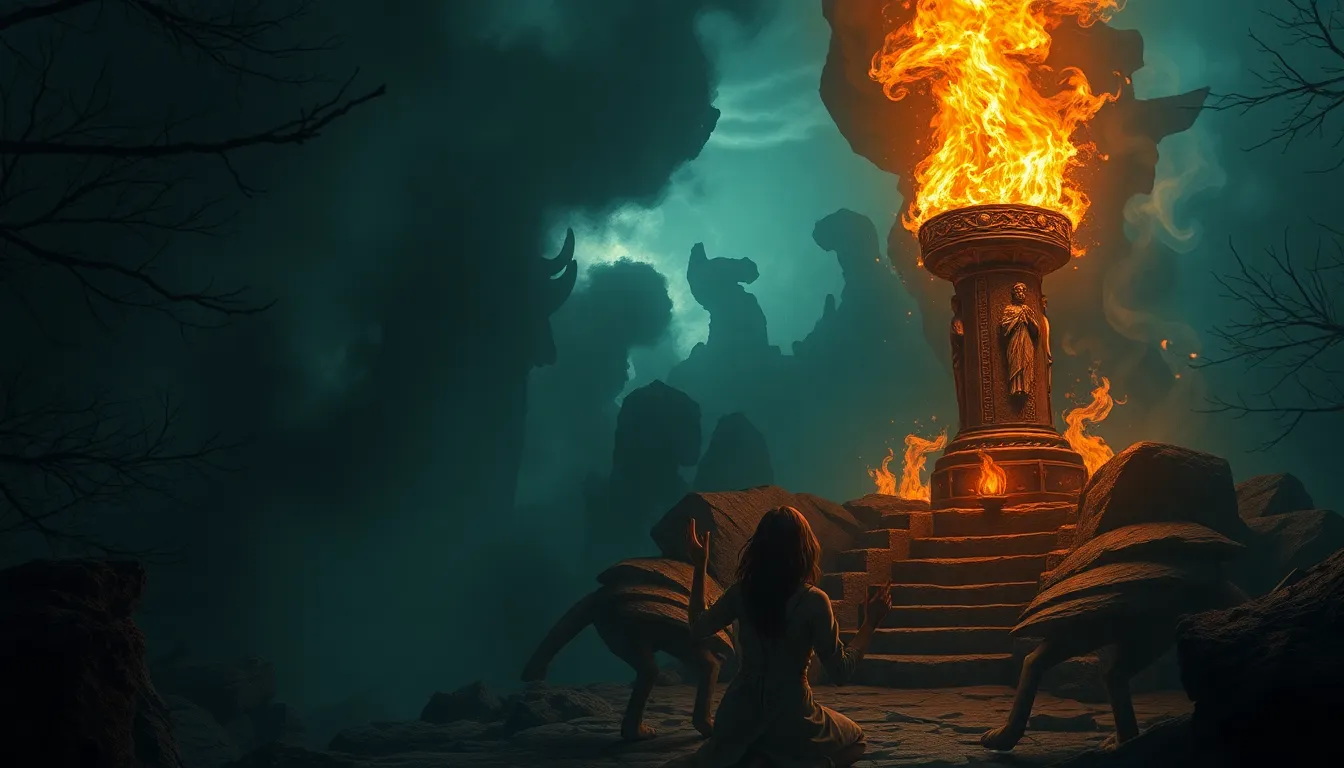The Helm of Darkness: The Power of Invisibility in Myth
I. Introduction
The Helm of Darkness, also known as the Cap of Invisibility, is one of the most intriguing artifacts in Greek mythology. This legendary item grants its wearer the power to become invisible, a concept that resonates deeply with various themes in myth and storytelling. Invisibility, as a motif, holds significant importance in folklore, often representing not only the ability to elude detection but also the complexities of power, fear, and identity.
This article aims to explore the origins of the Helm of Darkness, its role in mythological narratives, its cultural implications, and its enduring legacy in modern storytelling.
II. Origins of the Helm of Darkness
The Helm of Darkness has its roots deeply embedded in Greek mythology. It is often associated with Hades, the god of the Underworld, who is featured prominently in various myths. The helm symbolizes the realm of the dead and the power of invisibility that comes from the ability to move between worlds.
Historically, the helm was said to have been created by the Cyclopes, skilled artisans who forged weapons for the gods during the Titanomachy, the great battle between the Titans and the Olympians. This artifact represents not only the literal act of becoming unseen but also the deeper symbolism of fear and the unknown that accompanies death and the afterlife.
III. The Role of Invisibility in Mythological Narratives
Invisibility is a compelling motif that appears across various mythological narratives. It often serves as a tool for characters to achieve their goals, evade enemies, or explore the hidden realms of existence. Some notable aspects include:
- Power Dynamics: Invisibility can empower characters, allowing them to exert control or influence without being seen.
- Morality and Ethics: The act of being unseen raises questions about morality, as characters may exploit their invisibility for nefarious purposes.
- Isolation vs. Freedom: While invisibility can grant freedom from observation, it can also lead to feelings of isolation and disconnection from others.
When compared to other mythological artifacts, such as the Golden Fleece or Excalibur, the Helm of Darkness offers a unique perspective on the effects of invisibility on characters and their stories. It highlights the duality of power—while it can enhance one’s abilities, it can also lead to significant moral dilemmas.
IV. The Helm in Greek Myths
The Helm of Darkness appears in several key Greek myths, most notably in the story of Perseus and Medusa. In this tale, Perseus receives the helm from Hades to aid him in his quest to behead Medusa, a Gorgon whose gaze turns men to stone. The helm allows Perseus to approach Medusa unnoticed, demonstrating the strategic advantage of invisibility in heroic narratives.
Additionally, Hades himself used the helm during the Titanomachy, allowing him to evade detection as he fought alongside the Olympians. The helm’s influence extends beyond the realm of gods and heroes, affecting interactions between mortals and immortals, as those who wield invisibility often manipulate circumstances to their advantage.
V. Invisibility Across Cultures
Invisibility is not exclusive to Greek mythology; similar artifacts can be found in various cultures. For instance:
- Norse Mythology: The ring Draupnir, which can multiply wealth, also has associations with invisibility and hidden treasures.
- Egyptian Mythology: The god Thoth possessed knowledge that allowed him to navigate between the seen and unseen worlds.
These cultural interpretations of invisibility reveal thematic parallels, such as the pursuit of knowledge, the nature of power, and the unseen forces that govern life and death. While different cultures portray invisibility in unique ways, the underlying motifs often intersect, illustrating the universal fascination with what lies beyond the visible realm.
VI. Psychological and Philosophical Implications of Invisibility
The concept of invisibility carries profound psychological and philosophical implications. It serves as a metaphor for power and fear, encapsulating the human experience of feeling unseen or unrecognized. Some key considerations include:
- Power and Control: Invisibility can symbolize the ultimate form of power—being able to act without consequence or accountability.
- Freedom vs. Isolation: The duality of being unseen results in a tension between the freedom it offers and the isolation it enforces.
- Ethical Considerations: The ability to be invisible raises questions about the morality of one’s actions when they go unobserved.
These themes invite reflection on the nature of visibility in society, particularly in contexts where individuals may feel marginalized or overlooked.
VII. The Helm of Darkness in Modern Literature and Media
The Helm of Darkness continues to inspire modern literature and media, appearing in various adaptations and reinterpretations of myth. In contemporary storytelling, invisibility is often portrayed in diverse ways:
- Films: Movies like “Harry Potter” feature invisibility cloaks that parallel the helm’s powers.
- Books: Novels often explore characters who possess the ability to become invisible, using it as a plot device to navigate complex moral landscapes.
These representations not only enrich character development but also influence plot dynamics, often highlighting the tensions between visibility, power, and identity.
VIII. The Helm’s Legacy and Symbolism Today
The Helm of Darkness retains its symbolic weight in modern contexts, often represented as a metaphor for the unseen forces in our lives. In today’s society, invisibility is increasingly relevant in discussions surrounding:
- Surveillance: The concept of being watched contrasts sharply with the desire for privacy and invisibility.
- Social Issues: Invisibility can mirror the experiences of marginalized groups who feel overlooked or ignored in society.
This enduring fascination with invisibility reflects a broader human concern with understanding the unseen aspects of existence and the implications they hold for power dynamics in modern life.
IX. Critiques and Interpretations of the Helm
The Helm of Darkness has been the subject of various scholarly critiques and interpretations. Some notable perspectives include:
- Scholarly Analysis: Scholars have explored the helm’s significance within the context of power, mythology, and the human psyche.
- Feminist and Postcolonial Readings: These interpretations examine the implications of invisibility in terms of gender and colonial narratives.
Understanding the helm through these lenses enriches contemporary mythological studies and challenges traditional narratives surrounding power and visibility.
X. Conclusion
In conclusion, the Helm of Darkness stands as a powerful symbol of invisibility in mythology, encapsulating themes of power, fear, and identity. Its significance extends beyond ancient tales, resonating with modern discussions about the nature of visibility in society. The allure of invisibility continues to inspire curiosity and reflection, inviting us to explore further mythological artifacts and their meanings.




